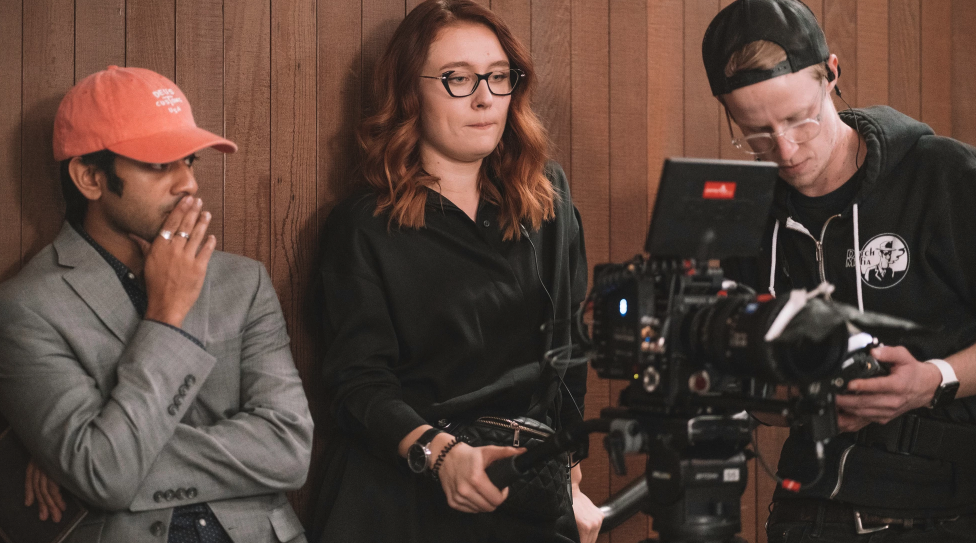When writer/director Sy Huq set out to make “Things That Fall,” a film about two people who had very different relationships with sound and hearing, he was simply trying to tell a story about love and connection. And when he was joined by producers Rafaella Biscayn and Tommy McNamara, they set out to tell the story authentically and inclusively.
What they didn’t quite expect was that their story would reach so many people, garner multiple awards, and qualify as a Best Live Action Short Film in consideration for the 92nd Academy Awards.
“Things That Fall” follows two characters. The first is a college student who experiences auditory hallucinations related to schizophrenia. The other is a hard-of-hearing classmate. When they meet in the quiet of a library, they make a connection that goes beyond the auditory.
Since its release, the film has been around the world at various festivals, was a runner-up in the 2019 AT&T Film Awards New Forms of Storytelling category and, was a winner of the Stage 32 Short Film Contest. Last week, the team discovered that they had qualified for the 2020 Oscars and were in the running for the Best Live Action Short Film shortlist.
Submittable sat down with Huq and Biscayn to talk about “Things That Fall,” how to make inclusive art, and what to do when you’re faced with a wall of rejection.
How does it feel to have a film qualify for Oscar consideration?
Sy Huq: I’m completely ecstatic. Extremely grateful is the most prominent feeling of them all. To be able to utilize this film in a way that we are heard and to impact people through this medium is what has mattered most to me.
Rafaella Biscayn: One of the things that keeps blowing us away along the way on this journey is the incredible amount of support that we’ve been receiving from not only filmmakers and film lovers, but also all of these organizations and associations. And it’s truly blown us away to realize we’re doing something good and raising awareness.
Tell us about your experience with the AT&T Film Awards.
SH: I’ve was a fan of what AT&T put out the year before—I went to SHAPE to see the films the year before as well. So when we learned that we were one of the winners in the New Forms of Storytelling category, everything came full circle.
Edward Schmidt at AT&T really championed our film and put in front of the right eyes during the SHAPE event. The AT&T Awards were there at the very beginning and it really did act as a catapult to slingshot us into the public light. They’ve continued to support us as we continue to tell our story.
Let’s take some time to talk about the film itself—where did the story come from?
SH: It started off as a personal story that was inspired by my late uncle who dealt with auditory schizophrenia and a friend of mine that, during college, felt like they heard voices. One of my best friends is from the deaf and hard-of-hearing community and she had a card interpreter. And when I was a business school and I saw how strong and grounded she was.
I always thought that both things needed to be represented more on film. And this script showed that kind of strength within challenges and how you can be empowered by reaching out and communicating—without even saying a word.
THINGS THAT FALL is now an Official Submission of the 92nd Academy Awards, in the running for Best Live Action Short Film! We couldn’t have done it without you, thanks to everyone who spread the word, caught the film on the big screens, and will do so! @TheAcademy @Om_Films pic.twitter.com/3yXRgLpndI
— SYサイ (@Sy_Huq) October 8, 2019
How does sound play a role in your film?
SH: Austin Seltzer came in with expertise on how to sonically paint the movie. We had the idea of basically creating a 360-degree soundscape to allow the audience to experience a simulation of what it’s like to hear voices and to experience what our character is going through. And it’s not only like the negative voices that we’ve always seen in film before, but also the positive and neutral voices—we wanted to represent that as much as possible.
I think AT&T really recognized our use of binaural audio—it’s as if a human is hearing it in real life. Like, you’ll actually hear like a snap on the side of your left side of your ear at the distance that it was recorded.
RB: People watching the film in the theater or watching it with headphones have turned around thinking that someone was whispering behind them. But it’s actually coming from the movie.
SH: So, we’re trying to implement that kind of technology into film and hopefully we’ve used it with a theme that has been able to make an impact as well. In that kind of dovetail, we’re trying to make this love story and this character come to life for people too, and have them realize and experience with him what he’s going through.
RB: The movie is not only to raise awareness, but to remind people to reach out and connect and communicate. With social media and phones and other technologies, we’re becoming disconnected from each other. And that’s not the way to live life.
Tell us about your decision to cast someone who is hard-of-hearing for the role of Carly.
SH: It was definitely our intention from the very start, before even the preproduction process. The best way to represent a deaf character on screen is to hire deaf talent for the role.
During the casting process, we came across Stephanie Nogueras, one of the first few people we actually talked to about the film. There was immediately a spark; she was perfect for the role. She knew exactly what that character is going through. She knows exactly what that character can bring to light and convey to the audience.
RB: And her disability was not the reveal. It was just part of who she was. It’s just a trait of her character.
SH: Exactly. Every step of the way we made sure that we were representing the community well. And Stephanie had creative insights that a hearing person wouldn’t have that made the film better. In the very last scene she suggested not include subtitles, as we had before, because it would put the audience in the seat of our main character, Alex, who wouldn’t be able to understand what she’s signing.
You’re working with some mental health organizations as well.
SH: That was very key to the sound design aspect of it as well. We worked with the National Empowerment Center and the National Center for Mental Health Recovery. They got to see early cuts of the film and give us insight on if everything was represented correctly. Having their support has been key.
RB: It’s not only that we’re talking with these groups to make sure that the film’s accurate—they add to the film and make it better through their insights. That’s what truly completes it and makes it authentic. It was crucial to have their input.
SH: A big part of our entire process is that we keep a very open mind and open heart to every creative input. If you cut conversations off, you’re doing yourself a disservice.

On the set of ‘Things That Fall’, courtesy of Sy Huq.
What’s your advice for up and coming filmmakers?
SH: The vision and the story ultimately lies with the filmmaker. But to be able to trust the people around you is the most important thing. It takes the expertise and knowledge of everyone on the team, and together you’ve gone through the mistakes of a million different stories on a million projects and sets. You need a village, a team you can trust.
RB: If I were to give any advice to up and coming filmmakers, producers, directors, it is not to have a Plan B, which I know is so scary. I believe that if you really love what you do and you’re passionate, you will get there. Keep going, keep meeting people, keep being creative and creating. Don’t wait for other people’s permission.
How do you deal with failure and rejection?
SH: Rejection is always a positive lesson. If you are rejected in a submission or a venture you spent a lot of time on and it ultimately came down to one decision and it didn’t work out because the decision maker had the wrong cheesecake that day—we blame ourselves, but it could be out of your hands. The cheesecake one is a personal experience.
Ultimately, the way to deal with rejection in a positive manner is to take a step back from the rejection and look at it as a lesson learned. If there is something that I can improve, where can I improve it? What can I do better? If you get rejected the first time, polish it up and make it better the second time and third time and the fourth time.
RB: It’s being not only open-minded to criticism, but to recognize that it could be for the best. And some things are so out of your control—that’s business. Try not to blame yourself or feel guilty. Elevate that criticism to be positive. I think if you always present the best and you’re talented, people will remember that, even if the project isn’t a good fit and you don’t get it. It might not be for this opportunity, but down the line something great will come of it.
You’ve said you’re going to turn this into a feature-length film.
SH: It’s the most exciting part of everything right now! Yeah. We’ve been developing it for quite a while now. During the making of the short film, it’s all about the character. In this film, you understand that it’s about the worlds that they live in. After a lot of deliberation and mapping out the plot in the story, we want to take these two characters and build the world around them.
RB: We’re on a roll. We’re on the climb right now, trying to take this development, to the next light, the next stage. We’re really excited to see the continuous impact that these two characters can bring to the world.
This interview has been edited for length and clarity.
This announcement was sponsored by Submittable partner AT&T. Submissions for the 2020 AT&T Film Awards are open through April 30, 2020 . Categories include Spanish-language, Youth Film Concept, Merged or Augmented Reality, Virtual Reality, and Mobile/360/Drone. Complete information regarding submission rules, deadlines, and eligibility are available at attfilmawards.submittable.com.
Read more about the 2019 AT&T Film Award Winners.
